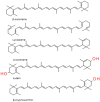Antioxidants in Cardiovascular Therapy: Panacea or False Hope?
- PMID: 26664900
- PMCID: PMC4671344
- DOI: 10.3389/fcvm.2015.00029
Antioxidants in Cardiovascular Therapy: Panacea or False Hope?
Abstract
Oxidative stress is a key feature of the atherothrombotic process involved in the etiology of heart attacks, ischemic strokes, and peripheral arterial disease. It stands to reason that antioxidants represent a credible therapeutic option to prevent disease progression and thereby improve outcome, but despite positive findings from in vitro studies, clinical trials have failed to consistently show benefit. The aim of this review is to re-appraise the concept of antioxidants in the prevention and management of cardiovascular disease. In particular, the review will explore the reasons behind failed antioxidant strategies with vitamin supplements and will evaluate how flavonoids might improve cardiovascular function despite bioavailability that is not sufficiently high to directly influence antioxidant capacity. As well as reaching conclusions relating to those antioxidant strategies that might hold merit, the major myths, limitations, and pitfalls associated with this research field are explored.
Keywords: N-acetylcysteine; allopurinol; antioxidants; carotenoids; polyphenols; vascular disease; vitamin C; vitamin E.
Figures






References
Publication types
LinkOut - more resources
Full Text Sources
Other Literature Sources
Research Materials

